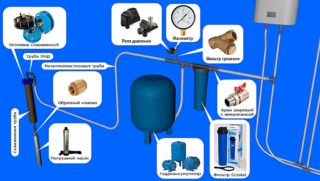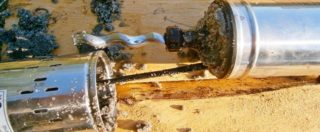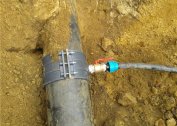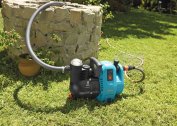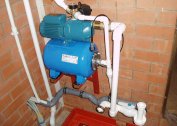The main working part of an autonomous water supply system is a pumping station. It includes units that maintain constant pressure in the pipeline. There can be many causes of technical malfunctions. The most common problem is that the pump in the well does not turn off automatically. It is difficult to find a definite solution, since several factors influence the rhythm of work at once.
The main malfunctions in the operation of the downhole pump and methods for their elimination
Most well pump models are typically designed for a limited number of starts per unit time. In the passport attached to the equipment, the manufacturer indicates the permissible number of shutdowns / starts per hour. The water pump in the well often turns on if the number of starts varies between 15-30.
If the pump stops working correctly, its performance decreases, all measures must be taken immediately to fix the problem. Otherwise, the unit will overheat and burn out or the breakdown will become more significant.
Violations of the pressure regulator
If the well pump turns off and on very often, one of the reasons is the malfunction of the pressure regulator. To verify its performance, perform a series of sequential actions.
First of all, the readings of the built-in pressure gauge are checked if it is included in the package of the pumping well station. Manipulation can be carried out using a car pump with a built-in pressure gauge.
Checking the adjustment unit is carried out according to the following algorithm:
- remove the protective cover from the pump;
- pump air into the battery cylinder through the safety valve, creating working pressure in it at the minimum acceptable level;
- by turning the rotary screw counterclockwise, lower the pressure threshold at which the unit should automatically turn on;
- bleed air and pump it up again, repeat the manipulation several times.
The downhole pump relay should automatically operate when the minimum pressure is reached. They are indicated in the attached documentation, as a rule, this manual or instruction manual.
The submersible pump may stop working due to an overestimated maximum permissible threshold on the relay. The optimal level is 95% of the maximum allowable pressure in the water supply system.
If the water from the well goes jerky, and then completely stops, the condition of the equipment inlet is checked. Perhaps it is clogged with sand, silt, mud and small algae. To fix the problem, it is enough to remove dirt with a hard brush.
Discharge pump outages
In a private house, the water supply system will often turn on if there is a power outage. If the equipment is not provided with electricity at the proper level, the impeller is not able to develop the required power. Under such operating conditions, the pump will not be able to create the maximum pressure in the pipeline, so it will work without interruption.
The lack of power is also the result of a malfunction in the individual components of the pump, for example, mechanical or electrical.
The main causes of power shortages:
- Clogged inlets and outlets. To fix the problem, rinse and clean the parts with detergents and brushes with abrasive particles.
- Oxidation of terminal box surfaces: they are cleaned with fine sandpaper. It is important to disconnect the appliance from the power source first.
- Unstable voltage. The vibration test must be carried out with the pumping station running. There is only one way to fix the problem - additionally install a voltage regulator.
In the process, the mechanical parts of the device inevitably wear out, which negatively affects the power and productivity of the equipment. You can check the pump performance by carefully inspecting it after disconnecting it from the outlet water supply.
A weak pressure indicates a strong deterioration of parts. Most of them can not be repaired, so the working nodes often have to be replaced entirely.
Pressure accumulator problems
A common cause of frequent pump starts is a malfunction of the accumulator. If the integrity of the tank is violated, this will inevitably lead to a drop in operating pressure in the pipeline.
If the damage is significant, most likely you will have to completely replace the battery.
Other reasons
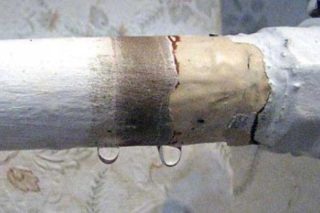
If the checks show that the parts are in good condition, it is time to proceed with the audit of the pipeline.
The pump often starts up for the following reasons:
- In the pipeline, depressurized sections or fistulas on the pipes formed. Leakage inevitably leads to pressure loss in the water supply system.
- The feed pipe is clogged with sand, silt, small algae and other particulate matter. This leads to a decrease in throughput and a decrease in pressure. If measures are not taken in a timely manner, the water will stop flowing into the house, and the components of the equipment will overheat.
- The water level fell in the well, the filling process slowed down.
The search for damaged places in the pipeline, located in hidden areas, is carried out by phased inspection of individual parts of the water supply network. The pressure in each must be measured using a manometer.
The inspected area can be considered suitable for further operation if, in the absence of water intake, the indicators on the manometer do not change within half an hour.
Frequent switching on of the pump can also be caused by pollution, or the entry of a foreign object into the check valve. To fix the problem, you need to disassemble the unit and remove the excess, in the end you must carefully rinse the water fittings. It is possible that the check valve has worn out and needs to be replaced because it has lost its tightness.
Preventative measures
In order to prevent or minimize the likelihood of serious damage to downhole equipment, it is necessary to carry out high-quality preventive maintenance at intervals of one year. This will allow you to timely identify problems in the operation of nodes. The ideal time for manipulation is spring and autumn.
- Carefully remove the submersible pump from the humid environment. On the surface, carefully examine the housing for minor malfunctions / scuffs, and also examine the condition of the electric cable and the suspended safety cable. Failure to pay attention to worn parts in a timely manner can lead to equipment breakdown or burnout due to a malfunction of the electrical cable.
- Examine the pump for deformation, dirt, or corrosion. Components must be thoroughly cleaned and rinsed with plenty of clean water.
If a large amount of silt or sand accumulates on the surface of the body, this indicates a sanding of the well. Therefore, flushing is required. Having lowered the pump into a container with clean water, it must be turned on and checked for the presence of extraneous noise. If any are observed, one of the nodes does not work correctly.
Problems with downhole pumps are not uncommon.This is usually due to non-compliance with the rules of operation and maintenance. It is necessary to take care of the work of the pumping station at the stage of e-purchase. It is important to choose the right model with optimal power, since a high-power model will work “idle”, wearing parts, and a low-power one will not be able to satisfy the buyer’s need due to technical limitations. Employees of housing and communal services or Vodokanal will be able to help in this matter.
